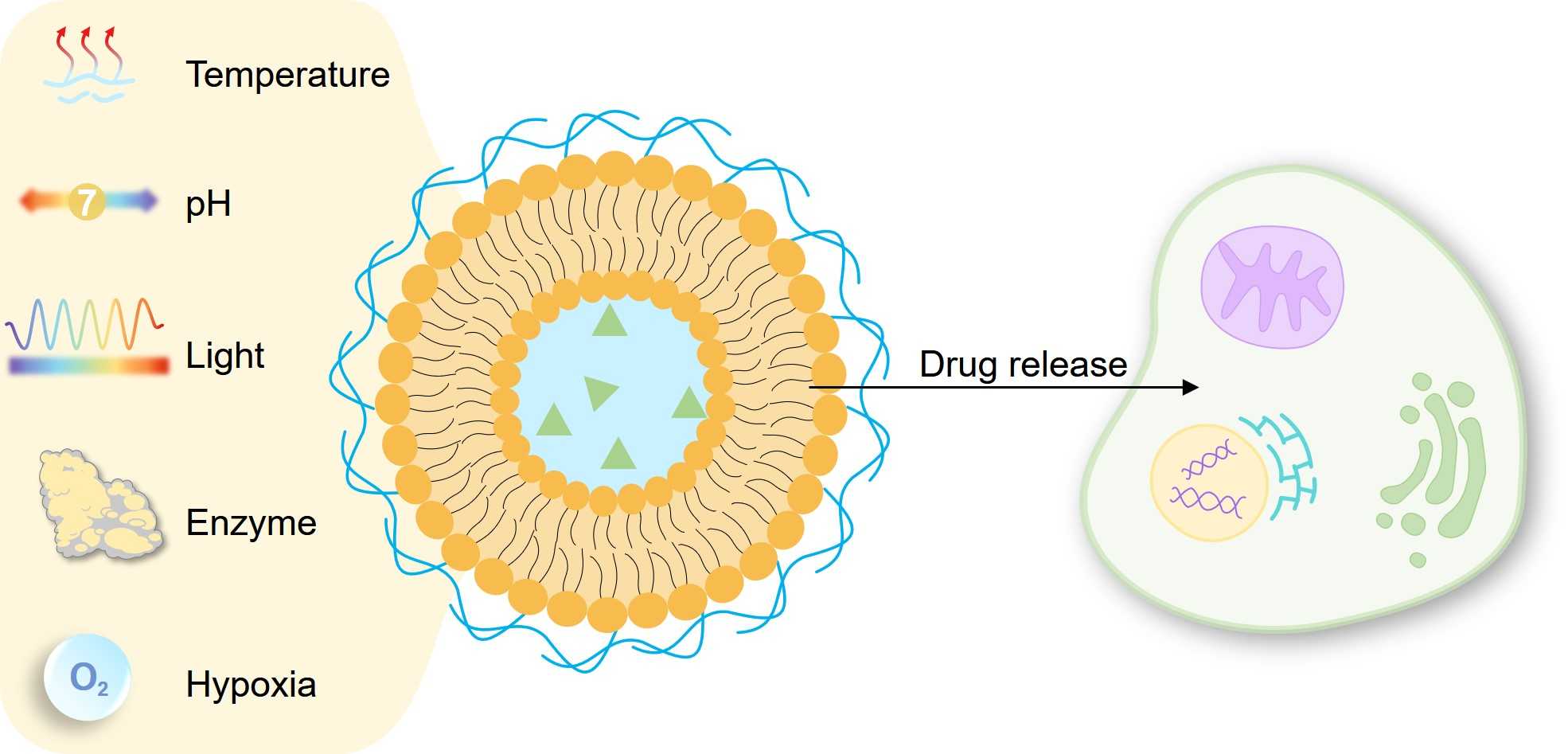Stimuli-responsive Polymer
Introduction Types Applications
Creative Biolabs is dedicated to providing clients with one-on-one development services for "smart" drug delivery systems. Depending on various in vivo environments, we can offer customized drug delivery systems based on stimulus-responsive polymers.
Introduction of Stimuli-responsive Polymer
Stimulus-responsive polymers, are often referred to as "smart", "intelligent", "stimuli-sensitive", or "environmentally sensitive" polymers. It exhibits changes in its structure, physicochemical properties, and functionality in response to various internal stimuli, such as pH, redox, enzymes, and hypoxia, or external stimuli such as light, magnetic fields, ultrasound, and temperature. Modifying liposomes with these polymers can not only enhance the stability of the liposomes and prolong the circulation time of the drug but also enable controlled drug release in response to stimuli.
 Fig.1 Liposomes based on stimuli-responsive polymers for controlled drug release.
Fig.1 Liposomes based on stimuli-responsive polymers for controlled drug release.
Types of Stimuli-responsive Polymers
Stimuli-responsive polymers can be categorized into single stimuli-responsive polymers and multi stimuli-responsive polymers.
|
Polymers
|
Stimuli
|
Advantages
|
Disadvantages
|
Applications
|
|
PCL
|
Heat, pH
|
Versatile adaptability
|
Low degradation rates and solubility
|
Drug delivery
Tissue engineering
|
|
PLGA
|
Heat
|
Ease of synthesis
Hydrolyzable
|
Limited biocompatibility
|
Drug delivery
|
|
Poly(amides)
|
Enzyme
ROS
|
Enzymatic cleavability
|
Cytotoxicity
|
Drug delivery
|
|
POEs
|
pH
Light
|
pH regulation
|
Highly hydrophobicity
|
Surgical sutures
Drug delivery
|
|
PEAs
|
Enzyme
Ultrasound
|
Programmability
|
Limited biocompatibility
|
Drug delivery
|
|
Poly(phosphoesters)
|
Enzyme
|
Biocompatibility
Versatile adaptability
|
Synthesis complexity
|
Drug delivery
|
|
Natural polymers
|
Enzyme, pH
|
Biocompatibility
|
Programmability
|
Drug delivery
Tissue engineering
|
-
Temperature-responsive Polymers
Temperature-responsive polymers are widely used and characterized by their critical solution temperature (CST). According to their CST, they can be categorized into lower critical solution temperature (LCST) polymers and upper critical solution temperature (UCST) polymers. LCST polymers phase separation above a certain temperature and homogenize below it, while UCST polymers show the opposite behavior.
Under acidic or basic conditions, the charge state or protonation state of the negatively charged (acidic) or positively charged (basic) moieties within functional groups can change, leading to alterations in the conformation and physical properties of pH-responsive polymers (such as solubility, chain conformation, and surface activity). There are differences in pH across various tissues in the body, and these variations can be leveraged for drug delivery to specific tissues. For instance, the pH of normal tissues is around 7.23; tumor tissues are acidic, with a pH of approximately 6.75; and the pH within lysosomes and endosomes ranges from 5.0 to 5.5.
-
Light-responsive Polymers
Light-stimulation is characterized by precise temporal and spatial localization, making it easy to adjust irradiation parameters. Light-responsive polymers typically contain molecules or functional groups that can absorb light energy. Under light exposure, these polymers undergo structural and morphological changes, which can lead to the rupture of liposomes modified by the light-responsive polymers and subsequently release the encapsulated drugs. Currently, extensively studied light-responsive polymers often include azobenzene (Azo), spiropyran (SP) and their derivatives.
-
Enzymes-responsive Polymers
The tumor microenvironment and within tumor cells often exhibit upregulated expression of specific enzymes, such as proteases, phospholipases, and peptidases. Enzymes-responsive polymers can be classified based on the type of enzyme they respond to. They typically incorporate enzyme-cleavable linkages into their polymeric backbone or as pendant groups.
-
Hypoxia-responsive Polymers
Hypoxia-associated pathological states are crucially involved in the metastasis and chemotherapy resistance observed in various cancers. Hypoxia-responsive polymers, featuring sensitive groups like azobenzene, can be utilized to prepare liposomes designed to disintegrate and release their payload under hypoxic conditions, selectively targeting hypoxic regions such as tumor sites.
-
Multi Stimuli-responsive Polymers
Compared to single stimuli-responses, the combination of multiple stimuli significantly enhances the controllability and range of polymer responsiveness. These multi stimuli-responsive polymers (such as pH/enzyme sensitivity, redox/enzyme sensitivity, and temperature/light/pH sensitivity) are conducive to facilitating the precise release of drugs and enhancing therapeutic outcomes. Typically, multi stimuli-responsive polymers incorporate several functional groups with distinct responsiveness, or they feature a single structure capable of responding to multiple different stimuli (such as Azo, acrylic acid, etc.).
Applications of Stimuli-responsive Polymers
-
Sensing and biosensing
-
Controlled-release drugs
-
Hydrogels
-
Micelles
-
Liposomes
-
Electrospinning
-
Other
-
Artificial muscles and actuators
As an industry-leading supplier, Creative Biolabs can provide you with customized lipid-based drug delivery systems based on stimuli-responsive polymers. This approach enables precise spatiotemporal control over drug release activity, thereby minimizing side effects and enhancing therapeutic efficacy. Contact us today to learn more about our services and how we can drive your project forward.

For Research Use Only. Not For Clinical Use

 Fig.1 Liposomes based on stimuli-responsive polymers for controlled drug release.
Fig.1 Liposomes based on stimuli-responsive polymers for controlled drug release.
 For Research Use Only. Not For Clinical Use
For Research Use Only. Not For Clinical Use
